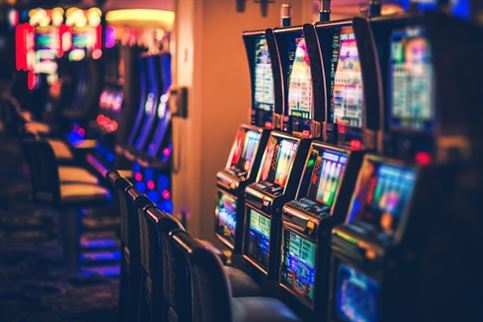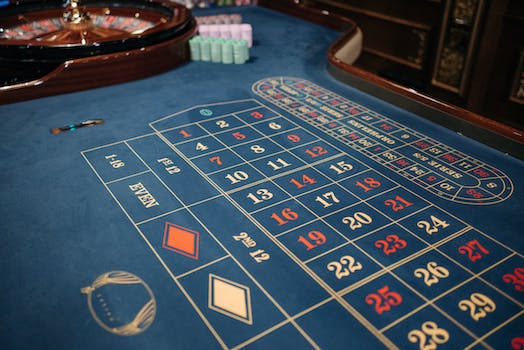The evolution of slot machines has been a fascinating journey that has spanned over a century. From the first mechanical slot machine, the Liberty Bell, to the modern-day video slots, the technology and design of these machines have undergone significant changes. In this article, we will explore the history of slot machines and how they have evolved over time.
The History of Slot Machines: From the Liberty Bell to Modern Day Video Slots
The history of slot machines dates back to the late 1800s when the first mechanical slot machine, the Liberty Bell, was invented by Charles Fey. The Liberty Bell was a three-reel machine that featured symbols such as horseshoes, diamonds, spades, hearts, and a cracked Liberty Bell. The machine was a huge success and quickly became popular in bars and saloons across America.
In the early 1900s, slot machines were banned in many states, but this did not stop the demand for them. Manufacturers found ways to get around the laws by creating machines that dispensed gum or candy instead of cash prizes. These machines were known as “gum machines” and were a huge hit with the public.
In the 1930s, the first electric slot machines were introduced. These machines were more reliable and could offer larger payouts than their mechanical counterparts. The first electric slot machine was called the “Mills Novelty Company Bell-O-Matic” and featured a new design that allowed for more symbols to be displayed on the reels.
In the 1960s, the first video slot machines were introduced. These machines used a television screen instead of physical reels and allowed for more complex games to be played. The first video slot machine was called “Money Honey” and was introduced by Bally Technologies. The machine featured a bottomless hopper that could hold up to 500 coins, making it possible for players to win larger payouts.
In the 1980s, the first computerized slot machines were introduced. These machines used a random number generator (RNG) to determine the outcome of each spin. The RNG ensured that each spin was completely random and fair, making it impossible for players to predict the outcome of the game.
In the 1990s, the first online slot machines were introduced. These machines allowed players to play from the comfort of their own homes and offered a wider variety of games than traditional land-based casinos. Online slot machines also offered larger payouts and more bonuses than their land-based counterparts.
Today, video slot machines are the most popular type of slot machine. These machines feature high-quality graphics, sound effects, and animations that make the games more engaging and entertaining. Video slot machines also offer a wide variety of themes, from classic fruit machines to movie-themed games.
In conclusion, the evolution of slot machines has been a long and fascinating journey. From the simple mechanical machines of the past to the high-tech video slots of today, slot machines have come a long way. Despite the changes in technology and design, the basic concept of the slot machine remains the same: to provide players with a fun and exciting way to win big.
The Technological Advancements that Revolutionized Slot Machines
Slot machines have come a long way since their inception in the late 1800s. The first slot machine, the Liberty Bell, was invented by Charles Fey in 1895. It was a simple machine with three reels and five symbols – horseshoes, diamonds, spades, hearts, and a Liberty Bell. The Liberty Bell was the highest paying symbol, and if three of them lined up, the player would win the jackpot of 50 cents.
The Liberty Bell was a huge success, and soon, other manufacturers started making their own versions of the machine. However, it wasn’t until the 1960s that slot machines started to evolve technologically. The first major technological advancement was the introduction of the electromechanical slot machine.
The electromechanical slot machine was invented by Bally Technologies in 1963. It was the first machine to use electricity to power the reels and the first to have a hopper that could hold a large number of coins. This meant that players could play for longer periods without having to constantly refill the machine with coins.
The electromechanical slot machine also introduced the concept of multiple paylines. Instead of just one payline, players could now bet on multiple paylines, increasing their chances of winning. The machine also had a new feature called the “hold” button, which allowed players to hold one or more reels in place while the others spun. This gave players more control over the outcome of the game.
In the 1970s, the first video slot machine was invented. The video slot machine was a huge leap forward in technology. Instead of physical reels, the machine used a video screen to display the symbols. This allowed for more complex games with multiple paylines and bonus features.
The first video slot machine was called Fortune Coin and was invented by Walt Fraley. It was introduced in Las Vegas in 1975 but was not initially well-received. Players were skeptical of the new technology and preferred the traditional mechanical machines. However, as the technology improved, video slots became more popular.
In the 1980s, video slots started to incorporate more advanced features, such as multiple screens and bonus rounds. The first multi-screen video slot machine was introduced by IGT in 1986. The machine had two screens – one for the main game and one for the bonus round. The bonus round was triggered by a certain combination of symbols and gave players the chance to win extra prizes.
In the 1990s, video slots became even more advanced. They started to incorporate themes and licensed content, such as movies and TV shows. The first licensed video slot machine was the Addams Family, which was introduced by IGT in 1992. The machine was based on the popular TV show and featured characters from the show as symbols.
Today, video slots are the most popular type of slot machine in casinos. They come in a wide variety of themes and offer a range of features, such as bonus rounds, free spins, and progressive jackpots. They also have advanced graphics and sound effects, making them more immersive and entertaining for players.
In conclusion, slot machines have come a long way since the Liberty Bell. Technological advancements have revolutionized the industry, from the introduction of the electromechanical machine to the invention of the video slot machine. Today, video slots are the most popular type of slot machine, offering players a wide range of features and themes. As technology continues to evolve, it will be interesting to see what the future holds for slot machines.
The Impact of Slot Machines on the Gambling Industry
The gambling industry has been around for centuries, and it has undergone significant changes over the years. One of the most significant changes has been the evolution of slot machines. From the first slot machine, the Liberty Bell, to the modern-day video slots, the slot machine has come a long way.
The Liberty Bell was invented by Charles Fey in 1895. It was a simple machine with three reels and five symbols – horseshoes, diamonds, spades, hearts, and a Liberty Bell. The Liberty Bell was the highest paying symbol, and if three of them appeared on the reels, the player would win the jackpot of 50 cents. The machine was an instant hit, and soon, other manufacturers started making their own versions of the Liberty Bell.
In the early 1900s, slot machines were banned in many states in the US. However, this did not stop people from playing them. The machines were often hidden in speakeasies and other illegal establishments. In the 1930s, the ban was lifted, and slot machines became legal again. This led to an explosion in the number of machines available, and manufacturers started to experiment with different designs and features.
One of the most significant changes in slot machines came in the 1960s when Bally introduced the first electromechanical slot machine. This machine used electronic components to control the reels, making it more reliable and easier to maintain. It also allowed for more complex game features, such as multiple paylines and bonus rounds.
In the 1980s, the first video slot machines were introduced. These machines used a video screen instead of physical reels, allowing for even more complex game features and animations. Video slots quickly became popular, and manufacturers started to experiment with different themes and designs.
Today, video slots are the most popular type of slot machine. They come in a wide variety of themes, from classic fruit machines to movie and TV show tie-ins. They also offer a wide range of features, such as multiple paylines, bonus rounds, and progressive jackpots.
The evolution of slot machines has had a significant impact on the gambling industry. Slot machines are now the most profitable game in most casinos, accounting for up to 70% of the total revenue. They are also the most accessible game, with machines available in almost every casino and many other establishments, such as bars and convenience stores.
However, the popularity of slot machines has also led to concerns about problem gambling. Slot machines are designed to be addictive, with flashing lights, loud noises, and the possibility of big wins. This has led to calls for stricter regulations on the design and operation of slot machines.
In conclusion, the evolution of slot machines has been a fascinating journey. From the simple Liberty Bell to the complex video slots of today, the slot machine has come a long way. It has had a significant impact on the gambling industry, both in terms of revenue and accessibility. However, it has also raised concerns about problem gambling, and it is important that regulations are in place to ensure that slot machines are operated responsibly.
The Psychology Behind Slot Machines and Their Addictive Nature
Slot machines have been a popular form of entertainment for over a century. From the first mechanical slot machine, the Liberty Bell, to the modern-day video slots, these machines have undergone significant changes. However, one thing that has remained constant is their addictive nature. In this article, we will explore the psychology behind slot machines and why they are so addictive.
The first thing to understand is that slot machines are designed to be addictive. The flashing lights, the sound of coins dropping, and the anticipation of a big win all contribute to the excitement of playing. The designers of these machines use a variety of techniques to keep players engaged and coming back for more.
One of the most effective techniques is the use of variable rewards. This means that the player is not rewarded every time they play, but rather at random intervals. This creates a sense of anticipation and excitement, as the player never knows when they will hit the jackpot. This is similar to the way that a gambler might feel when playing a game of chance, such as roulette or craps.
Another technique used by slot machine designers is the use of near misses. This is when the player comes close to winning, but falls just short. This creates a sense of frustration and encourages the player to keep playing in the hopes of finally hitting the jackpot. This is similar to the way that a gambler might feel when they lose a hand of poker by just one card.
The design of the slot machine itself also plays a role in its addictive nature. The flashing lights and bright colors are designed to stimulate the brain and create a sense of excitement. The sound of coins dropping and the spinning reels also contribute to the overall experience. All of these elements work together to create a highly stimulating environment that can be difficult to resist.
In addition to the design of the machine itself, the environment in which it is located can also contribute to its addictive nature. Casinos are designed to be highly stimulating environments, with bright lights, loud music, and a constant stream of activity. This creates a sense of excitement and encourages players to keep playing.
The social aspect of gambling can also be a factor in its addictive nature. Many people enjoy gambling as a social activity, and the presence of other players can create a sense of camaraderie and competition. This can make it difficult for a player to walk away, as they may feel that they are letting their fellow players down.
In conclusion, slot machines are highly addictive due to a combination of factors. The use of variable rewards, near misses, and the design of the machine itself all contribute to the overall experience. The environment in which the machine is located, as well as the social aspect of gambling, can also play a role. While slot machines can be a fun form of entertainment, it is important to be aware of their addictive nature and to gamble responsibly.
The Future of Slot Machines: Virtual Reality and Beyond
Slot machines have come a long way since their inception in the late 1800s. The first slot machine, the Liberty Bell, was invented by Charles Fey in 1895. It had three reels and five symbols – horseshoes, diamonds, spades, hearts, and a Liberty Bell. The Liberty Bell was the highest paying symbol, and if three of them lined up, the player would win the jackpot of 50 cents.
Over the years, slot machines evolved, and new features were added. In the 1960s, Bally Manufacturing introduced the first electromechanical slot machine, which used electronic components to determine the outcome of the game. This allowed for more complex game play and the introduction of new features such as multiple paylines and bonus rounds.
In the 1980s, the first video slot machines were introduced. These machines used a video screen instead of physical reels, allowing for even more complex game play and the introduction of new features such as animated graphics and sound effects.
Today, video slots are the most popular type of slot machine in casinos. They offer a wide variety of themes and game play options, from classic fruit machines to movie-themed slots with advanced graphics and animations.
But what does the future hold for slot machines? One possibility is virtual reality. Virtual reality technology has come a long way in recent years, and it is now possible to create immersive virtual environments that feel almost like the real thing.
Imagine stepping into a virtual casino, where you can walk around and interact with other players and slot machines. You could even sit down at a virtual slot machine and play a game, with the machine’s reels and buttons appearing in front of you in 3D.
Virtual reality slot machines could offer a level of immersion and interactivity that is not possible with traditional slot machines. Players could feel like they are really in a casino, and the experience could be tailored to their preferences and playing style.
Another possibility is the integration of skill-based elements into slot machines. Currently, slot machines are purely based on luck – the outcome of each spin is determined by a random number generator. But what if players could use their skill to influence the outcome of the game?
Some casinos have already introduced skill-based slot machines, where players can use their skill to trigger bonus rounds or increase their chances of winning. These machines are still in their early stages, but they could represent a new direction for slot machines in the future.
Of course, there are also concerns about the future of slot machines. Some people worry that the increasing use of technology in gambling could lead to addiction and other problems. Others worry that virtual reality and other advanced technologies could make gambling too immersive and realistic, leading to even more addiction and other problems.
Ultimately, the future of slot machines is uncertain. But one thing is clear – they will continue to evolve and change as technology advances and new ideas are introduced. Whether it’s virtual reality, skill-based elements, or something else entirely, the future of slot machines is sure to be exciting and full of surprises.
The Cultural Significance of Slot Machines in Pop Culture and Entertainment
Slot machines have been a staple in the world of gambling for over a century. They have evolved from simple machines with three reels and one payline to complex video slots with multiple paylines, bonus features, and interactive gameplay. The cultural significance of slot machines in pop culture and entertainment cannot be overstated. They have been featured in movies, television shows, and music videos, and have become a symbol of the glitz and glamour of Las Vegas.
The first slot machine was invented in 1895 by Charles Fey, a mechanic from San Francisco. The machine was called the Liberty Bell and had three reels with symbols of diamonds, spades, hearts, horseshoes, and the Liberty Bell. The machine was a hit and soon became popular in bars and saloons across the United States. The Liberty Bell was the first machine to use a payout system based on the combination of symbols on the reels.
In the early 1900s, slot machines were banned in many states, but they continued to thrive in underground gambling establishments. In the 1930s, the first electromechanical slot machine was invented, which allowed for more complex gameplay and bigger payouts. The first video slot machine was introduced in 1976, which used a computer screen instead of physical reels. This allowed for even more complex gameplay and the introduction of bonus features.
Today, video slots are the most popular type of slot machine in casinos around the world. They come in a variety of themes, from classic fruit machines to movie and TV show tie-ins. They also offer a wide range of betting options, from penny slots to high-limit machines that can cost hundreds of dollars per spin.
The cultural significance of slot machines can be seen in their portrayal in popular media. In movies like Ocean’s Eleven and The Hangover, slot machines are a symbol of the glitz and glamour of Las Vegas. In television shows like Breaking Bad and The Sopranos, slot machines are often used as a way for characters to launder money. In music videos like Lady Gaga’s “Poker Face” and Katy Perry’s “Waking Up in Vegas,” slot machines are a visual representation of the Las Vegas lifestyle.
Slot machines have also become a popular subject for artists and designers. In 2017, the Whitney Museum of American Art in New York City featured an exhibit called “Dreamlands: Immersive Cinema and Art, 1905-2016,” which included a section on slot machines. The exhibit showcased vintage machines from the early 1900s, as well as contemporary machines that use video and sound to create immersive experiences.
Despite their popularity, slot machines have also been the subject of controversy. Some people argue that they are addictive and can lead to problem gambling. In response, many casinos have implemented responsible gambling measures, such as self-exclusion programs and limits on betting amounts.
In conclusion, the evolution of slot machines from the Liberty Bell to video slots has had a significant impact on pop culture and entertainment. They have become a symbol of the glitz and glamour of Las Vegas and have been featured in movies, television shows, and music videos. While they have also been the subject of controversy, responsible gambling measures have been implemented to help prevent problem gambling. Slot machines will continue to evolve and remain a popular form of entertainment for years to come.
The evolution of slot machines has come a long way since the invention of the Liberty Bell in 1895. From mechanical machines to electronic ones, and now to video slots, the technology has advanced significantly. The introduction of video slots has brought about a new level of entertainment and interactivity, with various themes and bonus features. As technology continues to advance, it is likely that slot machines will continue to evolve and provide even more exciting experiences for players.




